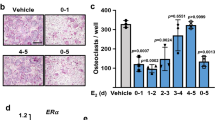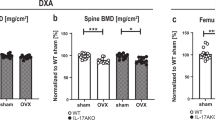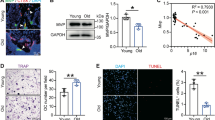Abstract
Postmenopausal osteoporosis, the most common bone disease in the developed world1, is associated with estrogen deficiency. This deficiency induces increased generation and activity of osteoclasts, which perforate bone trabeculae, thus reducing their strength and increasing fracture risk. Estrogen replacement prevents these effects2, indicating that estrogen negatively regulates osteoclast formation and function, but how it does this is unclear. Because functional osteoclast life span and thus the amount of bone that osteoclasts resorb could also be enhanced following estrogen deficiency, and since sex steroids regulate apoptosis in other target tissues3, we investigated whether estrogen may affect osteoclast function by promoting apoptosis. 17β–Estradiol promoted apoptosis of murine osteoclasts in vitro and in vivo by two– to threefold. Tamoxifen, which has estrogenic effects on bone resorption4, and transforming growth factor–β1 (TGF–β), whose production by osteoblasts is increased by estrogen5, had similar effects in vitro. Anti–TGF–β antibody inhibited TGF–β–, estrogen– and tamoxifen–induced osteoclast apoptosis, indicating that TGF–β might mediate this effect. These findings suggest that estrogen may prevent excessive bone loss before and after the menopause by limiting osteoclast life span through promotion of apoptosis. The development of analogues to promote this mechanism specifically could be a useful and novel therapeutic approach to prevent postmenopausal osteoporosis.
This is a preview of subscription content, access via your institution
Access options
Subscribe to this journal
Receive 12 print issues and online access
$209.00 per year
only $17.42 per issue
Buy this article
- Purchase on Springer Link
- Instant access to full article PDF
Prices may be subject to local taxes which are calculated during checkout
Similar content being viewed by others
References
Melton, L.J. How many women have osteoporosis now? J. Bone. Miner. Res. 10, 175–177 (1995).
Lindsay, R. Prevention and treatment of osteoporosis. Lancet 341, 801–805 (1993).
Pollard, J.W., Pacey, J., Cheng, S.V.Y. & Jordan, E.G. Estrogens and cell death in murine uterine luminal epithelium. Cell. Tissue Res. 249, 533–540 (1987).
Goulding, A., Gold, E. & Feng, W. Tamoxifen in the rat prevents estrogen-deficiency bone loss elicited with the LHRH agonist buserelin. Bone Miner. 18, 143–152 (1992).
Oursler, M.J. et al. Modulation of transforming growth factor-β production in normal human osteoblast-like cells by 17β-estradiol and parathyroid hormone. Endocrinology 129, 3313–3320 (1991).
Hughes, D.E. et al. Bisphosphonates promote apoptosis in murine osteoclasts in vitro and in vivo. J. Bone Miner. Res. 10, 1478–1487 (1995).
Takahashi, N. et al. Osteoclast-like cell formation and its regulation by osteotropic hormones in mouse bone marrow cultures. Endocrinology 122, 1473–1482 (1988).
Minkin, C. Bone acid phosphatase: Tartrate-resistant acid phosphatase as a marker of osteoclast function. Calcif. Tissue Int. 34, 285–290 (1982).
Wesolowski, G. et al. Isolation and characterization of highly enriched, perfusion mouse osteoclastic cells. Exp. Cell Res. 219, 679–686 (1995).
Grainger, D.J., Witchell, C.M. & Metcalfe, J.C. Tamoxifen elevates transforming growth factor-β and suppresses diet-induced formation of lipid lesions in mouse aorta. Nature Med. 1, 1067–1073 (1995).
Rotello, R.J., Lieberman, R.C., Purchio, A.F. & Gerschenson, L.E. Coordinated regulation of apoptosis and cell proliferation by transforming growth factor β1 in cultured uterine epithelial cells. Proc. Natl Acad. Sci USA 88, 3412–3415 (1991).
Jilka, R.L. et al. Increased osteoclast development after estrogen loss: Mediation by interleukin-6. Science 257, 88–92 (1992).
Liu, C.-C. & Howard, G.A. Bone-cell changes in estrogen-induced bone-mass increase in mice: Dissociation of osteoclasts from bone surfaces. Anat Rec. 229, 240–250 (1991).
Beaudreuil, J. et al. Short-term local injections of transforming growth factor-β 1 decrease ovariectomy-stimulated osteoclastic resorption in vivo in rats. J. Bone Miner. Res. 10, 971–977 (1995).
Erlebacher, A. & Derynck, R. Increased expression of TGF-β2 in osteoblasts results in an osteoporosis-like phenotype. J. Cell Biol. 132, 195–210 (1996).
Pfeilschifter, J., Seyedin, S.M. & Mundy, G.R. Transforming growth factor beta inhibits bone resorption in fetal rat long bone cultures. J. Clin. Invest. 82, 680–685 (1988).
Tashjian, A.H. Jr. et al. α and β human transforming growth factors stimulate prostaglandin production and bone resorption in cultured mouse calvaria. Proc. Natl. Acad. Sci USA 82, 4535–4538 (1985).
Bonewald, L.F. Can transforming growth factor beta be useful as a protective agent for pluripotent hematopoietic progenitor cells? Exp. Hematol. 20, 1249–1251 (1992).
Oursler, M.J., Pederson, L., Fitzpatrick, L., Riggs, B.L. & Spelsberg, T. Human giant cell tumors of bone (osteoclastomas) are estrogen target cells. Proc. Natl. Acad. Sci. USA 91, 5227–5231 (1994).
Smeyne, R.J. et al. Continuous c-fos expression precedes programmed cell death in vivo . Nature 363, 166–169 (1993).
Zheng, M.H. et al. Evidence that human osteoclast-like cells are not the major estrogen target cells. [Abstr.] Bone 16 (suppl.) 93S (1995).
Parfitt, A.M. et al. Relationships between surface, volume and thickness of iliac trabecular bone in aging and in osteoporosis. Implications for the microanatomic and cellular mechanisms of bone loss. J. Clin. Invest. 72, 1396–1409 (1983).
Parfitt, A.M., Mundy, G.R., Roodman, G.D., Hughes, D.E. & Boyce, B.F. A new model for the regulation of bone resorption, with particular reference to the effects of bisphosphonates. J. Bone Miner. Res. 11, 150–159 (1996).
Horowitz, M.C. Cytokines and estrogen in bone: Anti-osteoporotic effects. Science 260, 626–627 (1993).
Garrett, I.R. & Mundy, G.R. Relationship between interleukin-1 and prostaglandins in resorbing neonatal calvaria. J. Bone Miner. Res. 4, 789–794 (1989).
Hughes, D.E., Wright, K.R., Mundy, G.R. & Boyce, B.F. TGFbeta;1 induces osteoclast apoptosis in vitro . [Abstr.] J. Bone Miner. Res. 9 (suppl.) S138 (1994).
Turner, C.H., Sato, M. & Bryant, H.U. Raloxifene preserves bone strength and bone mass in ovariectomized rats. Endocrinology 135, 2001–2005 (1994).
Author information
Authors and Affiliations
Rights and permissions
About this article
Cite this article
Hughes, D., Dai, A., Tiffee, J. et al. Estrogen promotes apoptosis of murine osteoclasts mediated by TGF–β. Nat Med 2, 1132–1136 (1996). https://doi.org/10.1038/nm1096-1132
Received:
Accepted:
Issue Date:
DOI: https://doi.org/10.1038/nm1096-1132
This article is cited by
-
Immune microenvironment: novel perspectives on bone regeneration disorder in osteoradionecrosis of the jaws
Cell and Tissue Research (2023)
-
Osteoclast Recycling and the Rebound Phenomenon Following Denosumab Discontinuation
Current Osteoporosis Reports (2022)
-
Sexual dimorphism in the relation between sex hormones and osteoporosis in patients with type 2 diabetes mellitus
Journal of Bone and Mineral Metabolism (2022)
-
Osteocytes and Estrogen Deficiency
Current Osteoporosis Reports (2021)
-
Estrogens decrease osteoclast number by attenuating mitochondria oxidative phosphorylation and ATP production in early osteoclast precursors
Scientific Reports (2020)



